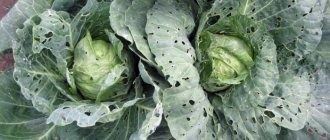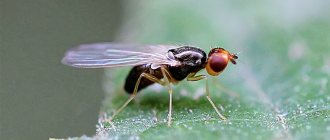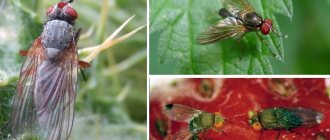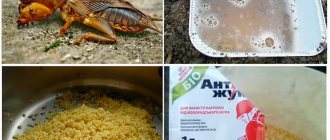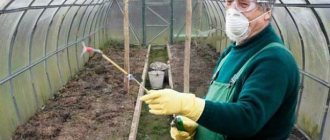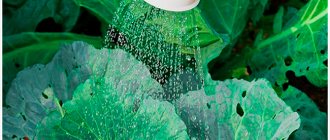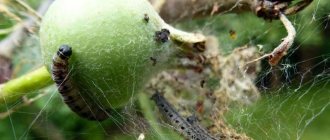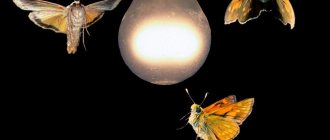Getting rid of slugs on cabbage is easy. Look for recipes in the article.
When growing vegetables, gardeners face many problems, including pests.
- Caterpillars and slugs on cabbage can not only damage the green leaves of this vegetable, but also completely destroy the crop.
- These insects can be detected thanks to the mucous trail on cabbage leaves.
- If you notice the first signs of the appearance of such pests, you must immediately save the crop.
- There are several proven methods for this. Read about them in the article below.
How to get rid of caterpillars and slugs on cabbage using folk remedies: tips, recipes
Slugs on cabbage
Gardeners are increasingly using traditional methods to control pests. They are safe for green crops and human health. Today, there are many folk ways to combat cabbage caterpillars and slugs. Here are some tips before starting work:
- Treat crops in the morning or evening, but not during the scorching sun, as this can harm the plants.
- If it rains after treatment, the procedure will have to be repeated, otherwise the caterpillars will attack the beds again.
- Do not make the solution for future use. Prepare it for one time immediately before use.
Tip: Be sure to constantly inspect the cabbage weeds in order to promptly notice the appearance of clutches of eggs or slugs and begin to immediately combat them.
Here are some effective ways to combat cabbage slugs:
- Beer. It doesn’t matter what kind of beer you use: stale or fresh, the caterpillars are attracted to the smell of this drink. Prepare several small plastic containers or regular glass jars. Bury them near the cabbage bushes and pour beer into the containers. Mollusks have a delicate sense of smell; they will immediately sense an alluring aroma and crawl towards it. After they fall into beer containers, you need to collect the slugs and burn them outside the garden.
- Instant coffee. You need to brew double instant coffee and sprinkle the cabbage leaves with this drink. It helps not only against slugs, but also against cabbage flies.
- Traps. You can make them from old rags that need to be wetted. Burlap or even old boards will also work. Wet the surface of the board or cloth well with water and place it near the beds. When the slugs crawl onto the wet traps, collect them and burn them outside the area.
- Close access to the beds. It is known that caterpillars and slugs crawl, moving with the help of a sole on their abdomen on flat surfaces. To prevent them from sneaking into the beds, you can sprinkle crushed egg shells, nuts, shell rock or coarse sand around the perimeter of the cabbage planting. Such a rough surface is an obstacle for slugs, as wounds may appear on their thin bodies.
These are some of the simplest and most effective ways to combat cabbage pests. There are other methods of struggle. Read below.
Why do they appear?
As a rule, gardeners themselves provoke the appearance of cabbage pests by improperly caring for the site.
Novice vegetable growers make mistakes especially often, but even experienced ones sometimes make the following mistakes:
- improper application of fertilizers;
- violation of crop rotation norms;
- improper soil cultivation for wintering and sowing;
- ignoring prevention;
- lack of quarantine for newly acquired plants.
Expert opinion
Mityuk Stefania Bogdanovna
It is better not to eat heavily affected fruits. Caterpillar poisons can severely poison vegetables.
It is extremely difficult to get rid of a pest if small butterflies have already begun to fly over the garden bed. If adult moths are circling over the garden, immediate treatment is necessary to prevent them from laying eggs.
How to treat cabbage from caterpillars and slugs with baking soda: folk recipes
Healthy cabbage leaves without slugs
Baking soda solution is one of the most effective ways to control pests in the garden. Baking soda is used in different forms, but most often as a solution. Experienced gardeners use this antiseptic at the seed soaking stage as a preventive measure, but this will be discussed below.
What to do if slugs have already appeared on cabbage leaves, how to treat them with baking soda? Here is the prescription:
- Dilute 10 grams of baking soda in 5 liters of warm, settled water.
- Mix well and sprinkle on the leaves.
You can even water the beds with this solution, since baking soda also fertilizes the soil, replenishing the lack of nutrients.
You can also mix soda with ash (2 tablespoons of soda per liter jar of ash) and sprinkle cabbage leaves with this powder. After rain, this technique will have to be repeated.
Another recipe for fighting slugs:
- Dissolve 10 grams of soda in 5 liters of water.
- Add 2 tablespoons of regular white flour and stir well.
- Then collect flower pollen (as much as you can - you won’t collect much of it) and also put it in the solution.
- Stir the mixture well and spray the cabbage leaves.
Slugs and caterpillars that fall off should not lie or crawl between the beds. They need to be collected and burned outside the garden. This recipe is used by older, experienced gardeners as the best recipe for controlling cabbage pests.
Signs and causes of appearance
The main reason for the appearance of such pests in cabbage beds is non-compliance with the rules of agricultural technology regarding:
- tillage in the autumn-spring period;
- compliance with crop rotation rules;
- carrying out preventive treatments and fertilizing;
- quarantine measures for recently acquired cultivated plants.
In the pupal stage, caterpillars overwinter in the upper layers of soil and plant debris.
With the arrival of warmth, they transform into adults and begin to lay eggs. Did you know? There are about 4,000 muscles in the body of a caterpillar, while in the human
body there are only 629. The muscles in the body of the larva play the role of a bony skeleton.
The main signs of the presence of caterpillars in areas planted with cabbage:
- the presence of dark spots on cabbage leaves is the excrement of caterpillars, which inhibit the processes of photosynthesis and provoke the occurrence of fungal diseases;
- holes on leaves;
- loss of turgor (intracellular pressure) by leaves;
- stopping plant growth.
How to poison caterpillars and slugs on cabbage with vinegar: folk recipes
Cabbage leaves eaten by slugs or caterpillars
To combat cabbage pests, 9% table vinegar is used. Here are effective recipes that you can prepare in a few seconds:
- Add 2 cups (400 ml) vinegar to a 10 liter bucket of water . Mix well and spray the cabbage leaves. Perfectly helps to cope with pests on seedlings or already mature heads of cabbage.
- Dissolve 1 glass of 9% vinegar and 50 grams of ammonia in 10 liters. Mix the solution well and spray the leaves. Helps against slugs and caterpillars of the Repnitsa and Belyanka butterflies.
- Dissolve 1 glass of 9% vinegar and 2 tablespoons of coarse table salt in 10 liters of water. Generously wet the leaves with the solution. Helps against butterflies, cabbage moths and slugs.
There is always vinegar in the house, so you can prepare such a solution without difficulty. Spray the leaves with it every 10 days and after rain.
Description of the pest
Caterpillars that eat cabbage are butterfly larvae. Adult females lay their eggs on the inside of cabbage leaves. In a short life cycle, butterflies reproduce 3 generations of their own kind. Each clutch contains 100 eggs.
Larvae emerging from eggs need a large amount of food to be able to move to the next stage of development (pupa). Butterflies can remain in the caterpillar stage from several days to several years, depending on the species. Caterpillars crawl onto the surface of cabbage mainly at night, and during the day they hide inside the fork or closer to the base of the leaves (at the initial stage of plant growth).
Important! Caterpillars, painted in bright, repellent colors and covered with a large number of hairs, are most often poisonous. Upon contact with such insects, a person's skin becomes covered with a rash.
Immediately after hatching, the caterpillars are very thin, with a short body. As they grow older, their length increases 15 times. The color of the larvae's body, depending on the species, can vary from green to dark brown. There are 3 pairs of true legs in the front part of the body, and 3-4 pairs of false legs in the abdominal region. During the entire larval period, the insect molts several times. Ultimately, the caterpillar pupates and undergoes the complete process of metamorphosis, turning into an adult winged adult (butterfly).
A complete list of butterfly larvae that feed on cabbage leaves:
- cabbage whites - green caterpillars with light stripes along the back and light yellow spots on the sides;
- cabbage moth — as the caterpillar matures, the color of the caterpillar varies from green to lemon yellow with pronounced dark dots;
- scoop — the color of the larvae can be gray, green, yellowish, gray-brown, brightly colored individuals are very rare;
- white turnip - greenish caterpillars with a longitudinal yellow stripe on the back and yellow dots on the sides.
Treating cabbage against caterpillars with toothpaste: folk recipes
Toothpaste
Experienced gardeners have long been using toothpaste to combat garden pests. You don't have to buy new tubes for this.
- You can collect used tubes during the winter, and then, when it’s time to fight insects, cut them and soak them in a bucket of water for a day, and in the evening, stir the solution and spray the cabbage.
- If you have thrown away your used tubes and need to fight pests now, then buy the cheapest toothpaste. Then dissolve 2 tablespoons of this dental cleaner in a bucket of water and spray the cabbage in the evening - at sunset.
In the morning you will not find a single insect in the beds. Where they go is unknown. Most likely, the insects will crawl to another place. But you don’t even have to remove fallen bodies of slugs or caterpillars from the beds - it’s convenient.
Ammonia for caterpillars on cabbage: folk recipes
Ammonia
If you do not have the necessary ingredients and you were unable to prepare a solution according to the above recipes, then you can use ammonia. Prepare this mixture from it:
- Dissolve fifty milliliters of ammonia in 10 liters of water.
- Add 1 cup of ash.
- Stir and spray the plants in the evening, before sunset. Two such treatments per season are enough.
Instead of ash, you can add 2 tablespoons of laundry soap shavings to the solution. Thanks to the soap, the solution will stay on the leaves for a long time and repel slugs and caterpillars. This mixture of drugs and water will definitely drive away harmful insects from the garden.
Basic information about the culture
The Cabbage family consists of many varieties. Cabbage happens:
- Headed. This subgroup includes white cabbage, red cabbage, and cabbage;
- Colored. The subgroup consists of cauliflower, broccoli, romanesco;
- Kohlrabi. A plant that produces a very turnip-like fruit on its surface. "Cabbage turnip" is used to make salads;
- Savoy. A distinctive feature of this species is the terry structure of the leaves. Salads and hot dishes are prepared from the vegetable;
- Beijing is an annual plant that has a rosette of leaves. Early ripening varieties are used for preparing salads, late ripening varieties are used for pickling and long-term storage;
- Chinese is a fast-ripening culture. Depending on the characteristics of the variety, it may have the shape of a head of cabbage or a loose rosette. The use of the vegetable is universal;
- Leafy is a biennial plant that forms a stem 1.5-2.5 cm high in the first half of the growing season, and a peduncle 1-1.5 m high in the second half. It is divided into flat-leaved and curly-leaved. Mainly used to decorate various dishes.
Cabbage is divided not only into types, but also into varieties, which, depending on the ripening period, are early, mid-ripening, and late-ripening. There are both regular varieties and varieties obtained by crossing two varieties. You should choose a type based on the characteristics of the type and your own needs.
Bay leaf against caterpillars on cabbage: folk recipes
Bay leaf
The easiest way to combat caterpillars and slugs on cabbage is to spread a bay leaf on the bed next to the crop seedlings. The smell of laurel will repel insects. You can also make a solution that will effectively help fight not only these crawling insects, but also the cabbage fly.
- Pour ten grams of bay leaf into one liter of boiling water.
- Leave the solution for half an hour until it cools completely.
- Then thoroughly wet the leaves with this solution, repeat after five days and after rain.
Remember: If you want to remove cabbage fly using a bay leaf, then this method is effective until the fly lays larvae. If this has already happened, then you need to resort to chemical treatment.
Useful tips for gardeners
Some useful recommendations from experienced gardeners:
- After treating plants against pests, they should be covered with a transparent thin mesh so that butterflies can no longer come into contact with plant tissues and lay eggs on them. The main thing is to make sure that the larvae are destroyed before covering the cabbage.
- Plant tomatoes and celery next to cabbage. The smell of these plants repels butterflies.
- To destroy caterpillars, collect ants, preferably together with soil from the anthill, and scatter them over the area. When the ants destroy all the pests, they will also leave the area to look for a new food source.
- When growing tomatoes, do not rush to throw away the greens; spread them over the surface of the cabbage. As the stepsons dry out, replace them with fresh ones.
Did you know? The silkworm, when pupating, produces a cocoon consisting of a continuous web 300–1500 m long.
By attacking plantings, caterpillars are capable of destroying the entire cabbage crop. But, if you follow the above recommendations and subsequent prevention techniques, you can get rid of them forever.
Garlic against caterpillars on cabbage: folk recipes
Garlic
Garlic is known to everyone as the best antiseptic in the fight against germs and bacteria of various origins. Gardeners also use it if they need to remove slugs and caterpillars from cabbage. Here is the prescription:
- Make an infusion of tomato leaves, onion stems and garlic (you can use both stems and heads).
- The solution should be saturated and fragrant . You will need about 3 kilograms of tomato tops, 1 kilogram of onion and garlic feathers or 10 heads of garlic. Instead of onion feathers, you can use onion peels (as much as will fit in a half-liter jar).
- Pour boiling water (10 liters) over it all and leave for 24 hours. Then spray the cabbage.
If you don’t want to collect tomato tops and onion peels, you can chop 10 heads of garlic and pour 8 liters of boiling water. Let the solution sit until it cools down, and then moisten the cabbage leaves generously with it.
Tomato tops
For this tool you will need:
- 1 kg of dried tomato leaves or 2 kg of fresh herbs;
- 5 liters of water.
Fill the tops with water, place the container on the burner, and after the liquid boils, simmer over low heat for 40 minutes. Use for spraying heads of cabbage without diluting. In a similar way, an infusion of wormwood is prepared, the smell of which is also destructive to garden pests.
The best chemical preparations for slugs and caterpillars on cabbage: instructions for use
Chemicals are also actively used by gardeners in pest control. Such modern means will help you quickly and mercilessly deal with caterpillars and slugs. The most popular such chemicals are:
The best chemicals for slugs
Remember: You need to spray the solution in dry, windless weather. Be sure to protect your face with a mask, your eyes with goggles, and your body with thick clothing.
Fighting caterpillars and slugs biologically: recommendations, preparations, instructions
Lepidocide
A biological method of controlling pests in the garden is the use of special fungi and bacteria. They naturally kill insects without harming people or plants. Organic farming has long reached a new level of development, and many gardeners are taking advantage of it.
Nowadays such drugs as Entobacterin, Lepidocid, Bitoxibacillin and Fitoverm are popular. The drug must be diluted in water (50 grams per bucket of water) and sprinkled on cabbage. The solution will enter the insect's body during a meal and lead to death.
The action of this method is as follows:
- Microbes, bacteria and fungi infect insects , which then get sick and die.
- When pests disappear, microbiological creatures also disappear . Treatment with the drug is carried out twice a season with an interval of one week.
- Treatment stops a week before harvest.
- The effect of the drug depends on the air temperature . If it is below 18 degrees Celsius, then bacteria will not multiply and the drug will not work. If the air temperature is above 30 degrees, then the bacteria may die without starting to act.
Remember: Be sure to choose a time of day to use the drug so that the air temperature is between 18-30 degrees.
What harm do they do?
The larvae feed on the sap of the plant, gnaw holes in the leaves and destroy the head of cabbage, penetrating to the core. These processes lead to a strong slowdown in plant growth at the initial stage and the complete destruction of the fork later. Moreover, each butterfly is capable of laying hundreds of larvae and producing two or three offspring per season. The lifespan of each caterpillar ranges from 15 to 30 days.
The scale of harm caused directly depends on the following factors:
- population level;
- a type of caterpillar (butterfly);
- stage of problem detection (in the early stages it is possible to prevent the death of the plant and the destruction of the head of cabbage).
Thus, over the course of a season, the population is capable of destroying a bed of cabbage of any variety and type. As a rule, early varieties are destroyed faster.
What to do to prevent slugs and caterpillars on cabbage: necessary measures
Prevention - planting calendula and other fragrant herbs
Everyone knows that prevention is better than cure. This popular saying also applies to gardeners. In order not to lose the harvest from the invasion of slugs, caterpillars and other pests, you need to take care of this in advance. Important preventative measures are as follows:
- Planting fragrant herbs and flowers . Their smell will repel pests. You can use calendula, coriander, lovage and celery. These plants also attract beneficial insects to the garden, such as ladybugs and other bugs. They feed on aphids and caterpillars.
- Attract birds to your garden . They feed on insects and help clear the garden of pests.
- You can use thin spunbond or fine mesh to cover the beds to block the path for butterflies to lay larvae.
- Remove weeds carefully . They attract butterflies.
- Inspect the cabbage leaves from below and remove egg clutches.
- Monitor the growth of the plant during the entire growing season , feed it, treat it, as a strong plant will be able to resist pest invasion.
- Treat seeds before germination . For example, in a baking soda solution: 5 grams of soda per 1 liter of water. Stir and soak the seeds for a day.
When choosing a pest control method, remember that preference should be given to traditional methods and microbiological preparations. They are safe for both humans and plants, and the use of chemicals can lead to the accumulation of carcinogens - substances hazardous to human health. Remember that well-kept land is no place for pests. Clear the garden of weeds, attract birds, and process the crops in a timely manner, if necessary. Have a good harvest!
How to detect
Neglecting regular inspection of fruits is one of the worst sins of a vegetable grower. An apparently healthy fetus can turn out to be a real “Trojan horse.” As soon as you remove several layers of leaves from such a head of cabbage, your eyes will appear swarming with larvae.
Catching lesions as early as possible is extremely important. Experienced farmers name the following factors as the first signs:
- Small holes began to appear . At first, the perforation is barely noticeable. It starts from the bottom and gradually rises, the size of the holes increases. Heavy infestation is characterized by almost continuous large holes.
- The leaves are covered with mucus . When moving, caterpillars leave slimy trails behind them.
- Moves have appeared on the heads of cabbage and the edges of the leaves have been eaten away . Most often these are the consequences of the cutworm, which is how it chews its way through.
- Excrement is visible. They look like small brown and black specks.
- The vegetable began to rot right in the garden . Waste products provoke putrefactive processes.
- The growth of the head of cabbage has stopped, the leaves are sluggish and thin . The new residents are drawing vitality from the cabbage.
Any of these signs, especially their combination, is a warning sign. In addition, you need to inspect the cabbage for the individuals themselves. At night they crawl out onto the leaves; during the day you have to look closer to the stalk.
Other vegetables also suffer from cabbage caterpillars. Carrots, beets, zucchini, other crops. In advanced cases, even flowers and fruit trees are affected.
